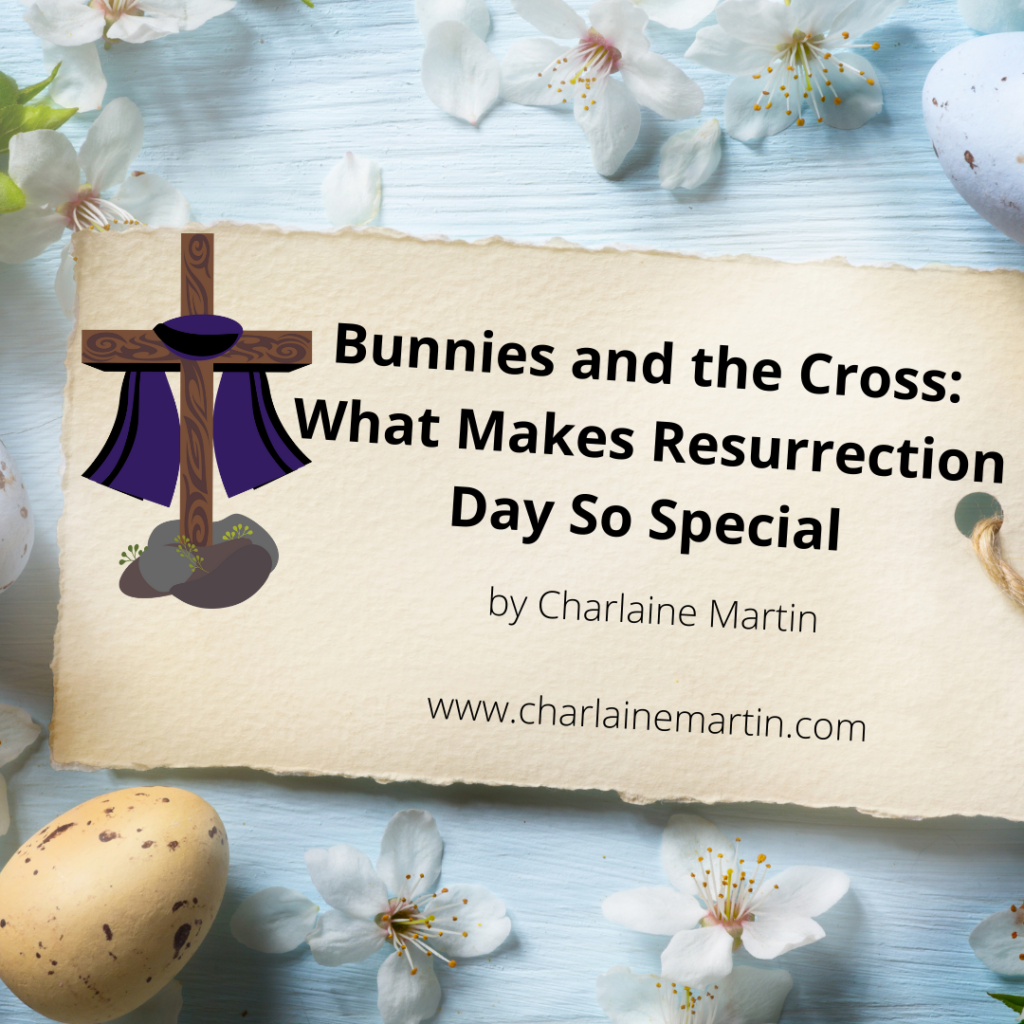Bunnies and the Cross: What Makes Resurrection Day So Special - Charlaine Martin

As my Boaz and I were driving home, I read a sign at a local daycare, “Silly Bunny! Easter is for Jesus!” I loved that statement. Why do parents and grandparents insist on teaching the kids to believe in the Easter Bunny rather than the glory of our Resurrected Lord? Emotional connections. That’s it. We often place greater value on our emotional attachments than the Truth of Jesus Christ, His death, and resurrection. Although we claim faith in Jesus Christ as Savior, we forget to allow Him to be Lord of our lives. We confuse our kids and grandkids by making Easter all about a fictional rabbit than about our very real Resurrected Savior.
Read: Luke 24:1-12, 36-53
Focus Verse: John 1:29 The next day John saw Jesus coming toward him, and said, “Behold! The Lamb of God who takes away the sin of the world!
What’s the Deal?
Stores are filled with Easter Bunnies, eggs, and brightly colored baskets. When we think of Easter, we often have these mental images, even though we celebrate the Resurrection of our Savior, Jesus, at church. We set up Easter egg hunts at church and home with many of the decorations we find at the store. The commercial version of Easter follows the pagan ideology of fertility. Yet our faith causes us to question, “What is Easter? Why the discrepancies between what our society values and our churches value? How do we shift from the secular bunnies, eggs, and candy to the biblical celebration of Jesus’ death and resurrection? How can we convey our Savior’s death and resurrection to our children and grandchildren in a way that ignites their faith? How do we address the discrepancies with our kids and grandkids? Let’s use Easter to prepare the way of the Lord for children’s hearts.
Dig In
In our passage, Jesus had already died. Joseph of Arimathea, a member of the Jewish Council (Sanhedrin), had him placed in a tomb he owned in which no one had ever been buried (Luke 23:50-53). He could only do so by asking Pontius Pilate to have the body removed from the cross. This move was a bold one because of Joseph’s status and the fact that Pilate didn’t know if Jesus was dead yet. He had to confirm it first, then they gave Joseph the body, and he took him to a rocky hill where the tomb had been cut out of the rock. He laid Jesus on the stone slab inside and covered Him with linen cloths.
The women, Mary Magdalene, Joanna, Mary mother of James, and others, went to the tomb to prepare Jesus’ body with spices. They could not do this critical task on the Sabbath, so they trekked to the grave where Joseph had shown them. This was a smelly proposition as bodies usually begin the decomposition process. However, it was not so with Jesus—because He wasn’t in the tomb! A seal had been placed to secure the tomb with Pilate’s guards stationed there (Matthew 27:62-64), but the Angel of the Lord rolled the stone away to reveal the opening. The guards placed there by Pilate passed out when they encountered the Angel but later ran into the city to tell the Chief Priests what happened. They were paid off to tell everyone that His disciples stole His body. (Matthew 28:1-15). As these women looked inside, t two angels appeared beside them and greeted them. They asked, “Why do you seek the living among the dead? He [Jesus] is risen from the dead just as he told you.” (v.v. 5-7). This encounter frightened the women, but the angels’ words jogged their memory about what Jesus taught them about His rising from the dead on the third day.
This third day is counted from Friday sundown. On the third day, Sunday morning, he rose from the dead. They expected to finish the burial preparations that hasten the decay process. His bones would be gathered with his ancestors, as was the Jewish custom. When these women found out He wasn’t there, they went to tell the others who followed Jesus. However, their news was met with skepticism. Peter was curious, though, and ran to the tomb to check out their story. He found just the linen on the stone slab wrapped around Jesus–and no body!
Later, Jesus appeared to them that His disciples would know He lives. They could see the nail wounds in his hands and feet, that He did indeed die on the cross and rose from the dead. It was a lot to take in. Then He stated the purpose of these events: the forgiveness for sins was offered if only people would repent. They were to preach this good news to everyone everywhere, beginning in Jerusalem. But they had to wait for the Holy Spirit, the power Jesus promised they would receive. They watched Him rise to Heaven, then worshipped and joyfully returned to Jerusalem to the Temple until they received the power of the Holy Spirit.
Luke’s portrayal of Jesus gives us the image of Him as a Priest, Prophet, and Messiah, the King of Kings (Zondervan, p. 288).
Pagan Roots Run Deep
Easter is confusing nowadays because lambs, rabbits, and eggs are featured alongside Christian and secular Easter advertisements and graphics. However, Easter is a pagan fertility celebration based around the spring equinox when daylight starts lasting longer, considered a time of rebirth, fertility, and renewal since before the dawn of Christianity (Gaia). The Council of Nicea determined that Easter should be celebrated with the fixed date of Easter in 325 AD (Brittanica). Essentially, the Spring Equinox coincides with the Jewish celebration of Passover. Nothing more. According to the Pagan Federation International, “paganism is the ancestral religion of the whole of humanity [which] remains active throughout much of the world today.” (Gaia) The polytheistic roots still run deep in our culture today. They don’t consider God’s relationship with humankind—i.e., Adam and Eve–as the original faith practice from the book of Genesis, not paganism—a human-derived religion that may have originated from the family line of Seth. Satan indeed is the author of confusion!
Decisions, Decisions
The confusion between pagan Easter and Christian Resurrection for Christians makes it difficult to pull away when we promise the Easter Bunny will hide Easter eggs and leave candy in brightly-colored baskets for the kids. So we knock ourselves out to follow through with that misplaced promise we make to them.
This fallacy is why we should consider what kind of stumbling block we place before our children and grandchildren’s faith in Jesus Christ as Savior and Lord. How does fertility trump Jesus’ death on the cross for our sins and His resurrection from the dead to offer us new life?
John the Baptist, a true rebel to the status quo of his time, went about preparing the way for the Messiah, his cousin, Jesus. In John 1:29, Jesus walked toward him at one point, and he said, “Behold! The Lamb of God who takes away the sin of the world!” We would do well to be more like John. So let’s use Easter to prepare the way of the Lord for children’s hearts.
Do It!
Are you prepared to run counter-culture like John? We read in Hebrews 13:14-16,
For here we have no continuing city, but we seek the one to come. Therefore by Him let us continually offer the sacrifice of praise to God, that is, the fruit of our lips, giving thanks to His name. But do not forget to do good and to share, for with such sacrifices God is well pleased.
It is both an honor and sacrifice to share the Good News of Jesus Christ with our children. Are you ready to lay your emotional attachment to secular Easter to rest? What better time than now. Rather than convincing children to believe in fictitious characters as real, let’s show them the Way, the Truth, and the Life.
Here are a few ways you can introduce children to the death and resurrection of Jesus Christ:
- Remove all images of the Easter Bunny and replace them with the Empty Cross and images of lambs When you decorate. Point them to New Life.
- Use plastic eggs to share the truth of Jesus’ death and resurrection by using images from the Stations of the Cross (age-appropriate, of course). Play a Hide and Find game to get as many eggs with each station in them as possible numbered in the order they happened. Other eggs can have other fun things inside. For example, each egg can have a piece of candy inside. Have older children tell the story from the images they find. Give a prize to the one who gets the most pictures of the story.
- When you read portions of the Easter story, help kids identify with Jesus during his betrayal, Judas’ payoff, and the beatings He took by talking about bullying. Kids can relate to how kids treat each other. Maybe sharing age-appropriate stories of bullying can help them understand what Jesus went through—without the gore. It’s also an excellent time to discuss death and why it’s so important that Jesus rose from the dead.
- Talk about new life symbols around you like baby birds, lambs, bunnies, etc. Share with children how Jesus offers us new life. Talk about Heaven in age-appropriate ways.
Make the truth of Jesus interesting, fun, and age-appropriate. Offer kids, as you see they understand salvation, the opportunity to accept Jesus as Savior and Lord. Only pray with them to accept Jesus as Savior if they show an understanding of what He did for them. If a child says they feel Jesus’ feet kicking around in their hearts, they are not ready. Then you can say, “Oh, that is interesting. Could it be that your heart is beating?” with a smile and move on to other discussion topics. Leading them in the sinner’s prayer when they don’t understand can actually be more harmful than helpful.
May the blessings of Easter abound in your heart! Let these blessings spill over into the lives of your children and grandchildren.
Resources:
Zondervan New Testament Commentary, by Zondervan Publishing. Copyright 1994, Zondervan Corporation. Grand Rapids, Michigan. p.p. 284-285, 287-288.
“Beyond the Easter Bunny: The True Origins and History of Easter” by Lisa Trank. Gaia, April 12, 2019. www.gaia.com.
“Easter, Holiday” by Hans J. Hillerbrandt. April 11, 2022. Brittanica. www.brittanica.com.
For Further Reading:
History.com https://www.history.com/topics/holidays/history-of-easter




